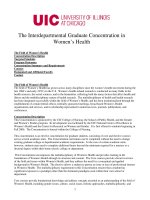THE PAPERLESS HOSPITAL- Healthcare in a Digital Age potx
Bạn đang xem bản rút gọn của tài liệu. Xem và tải ngay bản đầy đủ của tài liệu tại đây (3.26 MB, 345 trang )
THE PAPERLESS HOSPITAL
——————
Healthcare in a Digital Age
Management Series Editorial Board
Virginia V. Cohen, fache
Children’s Hospital Medical Center
Terence T. Cunningham, III, fache
Ben-Taub General Hospital
Mark A. Dame, che
Memorial Hospital
Marie de Martinez, che
St. Francis Medical Center
Kenneth C. DeBoer
Avera St. Luke’s Hospital
John Di Perry, Jr., che
Mercy Medical Center Redding
Irene Fleshner, che
Genesis Health Ventures
Michael R. Gloor, fache
St. Francis Medical Center
Maj. Michael S. Heimall, che
North Atlantic Regional Medical Command
Kathryn S. Maginnis, che
Department of Veterans A=airs
Karolee M. Sowle, fache
Desert Regional Medical Center
Katherine W. Vestal, Ph.D., fache
Cap Gemini Ernst
Alan M. Zuckerman, fache
Health Strategies & Solutions
THE PAPERLESS HOSPITAL
——————
Healthcare in a Digital Age
Russell C. Coile, Jr.
Health Administration Press
ACHE Management Series
HIMSS
Your board, sta=, or clients may also benefit from this book’s insight. For more informa-
tion on quantity discounts, contact the Health Administration Press Marketing Manager
at (312) 424-9470.
This publication is intended to provide accurate and authoritative information in regard
to the subject matter covered. It is sold, or otherwise provided, with the understanding
that the publisher is not engaged in rendering professional services. If professional
advice or other expert assistance is required, the services of a competent professional
should be sought.
The statements and opinions contained in this book are strictly those of the author(s)
and do not represent the o;cial positions of the American College of the Healthcare
Executives or of the Foundation of the American College of Healthcare Executives.
Copyright © 2002 by the Foundation of the American College of Healthcare Executives.
Printed in the United States of America. All rights reserved. This book or parts thereof
may not be reproduced in any form without written permission of the publisher.
05 04 03 02 01 5 4 3 2 1
Library of Congress Cataloging-in-Publication Data
Coile, Russell C.
The paperless hospital : healthcare in a digital age / by Russell C. Coile, Jr.
p. cm.
Includes bibliographical references.
isbn 1-56793-162-6 (alk. paper)
1. Hospitals—Administration. 2. Computer networks. 3. Internet. I. Title.
[dnlm: 1. Delivery of Health Care—organization & administration. 2. Computer
Communication Networks. 3. Hospital Administration—trends. 4. Internet.
W 84.1 C679p 2001]
RA971.23 .C65 2001
362.1'1'068—dc21
2001039442
The paper used in this publication meets the minimum requirements of American
National Standard for Information Sciences—Permanence of Paper for Printed Library
Materials, ansi Z39.48-1984. ™
Acquisitions manager: Audrey Kaufman; Project manager: Joyce Sherman; Text and cover
design: Matt Avery
Health Administration Press Healthcare Information and
A division of the Foundation of the American Management Systems Society
College of Healthcare Executives 230 East Ohio Street
1 North Franklin Street, Suite 1700 Suite 500
Chicago, il 60606-3491 Chicago, il 60611-3269
(312) 424-2800
A project like this takes me away
from my family more than I like to
be reminded. I want to dedicate
this book to my family, Nancy,
Amanda, and Ariel, who will live
in the digital future.
This Page Intentionally Left Blank
vii
Table of Contents
Foreword ix
Preface xiii
1 Introduction: The Digital Transformation of 1
Healthcare
2 Cyber-Health: Transforming Legacy Systems into 23
Enterprise Application Infrastructures
3 Report Cards: Competing in a Consumer-Driven 49
Marketplace
4 Connecting Businesses 77
5 E-Solutions: Harnessing the Internet for Business 105
Improvement
6 Web Strategies: The Internet and Customer 127
Relationship Management
7 Outsourcing: A Better, Faster, Cheaper Solution for 155
Technology Management
8 Call Centers: Managing Demand to Manage Care 177
9 Telemedicine: A New Foundation for Healthcare 201
Delivery
10 Medical Errors and the Science of Care Management 227
11 HIPAA, Electronic Privacy, and Internet Transactions 253
12 Managing Healthcare’s E-Organizations 283
Index 309
This Page Intentionally Left Blank
ix
Like any revolution, the digital transformation of healthcare
began almost imperceptibly many years ago. I witnessed one of its ear-
liest events without having any special awareness of what was to come.
The 400-bed hospital where I worked as a photographer installed its
first computer in the late 1960s, and I was asked to take pictures for
the press release announcing the hospital’s entry into the new world
of electronic data processing. The computing machine was more note-
worthy for its size than for its function. I remember the hospital’s pub-
lic relations director asking me to take pictures to showcase the half-
dozen new, refrigerator-sized boxes that filled an air-conditioned room
in the basement.
The automation of financial record keeping was not the big story.
The important message was that our hospital’s computer was literally
bigger than the neighboring hospital’s computer. A few employees
joked about being “replaced by a button,” but if anything was pre-
sumably foreshadowed by our new data processor, it was that even
bigger machines were coming. Indeed, the president of International
Business Machines (ibm) predicted at the time that the world would
soon be run by a handful of very big supercomputers. As best I can re-
member, all the attention was focused on computers as business ma-
chines. They were going to make traditional business more e;cient,
Foreword to The
Paperless Hospital:
Healthcare in a
Digital Age
x The Paperless Hospital: Healthcare in a Digital Age
providing better ways to do the same old things. Conventional wisdom
circa 1970 did not dictate that computers would redefine the very foun-
dations of business. And absolutely no one thought that the telecom-
munications industry would ever become a force of change.
Now, only three decades later, big mainframes have all but disap-
peared. Computer science and telecommunications are together cre-
ating a new realm of possibilities out of millions of small machines that
sit on our desks, rest in our laps, or hang from our belts. The net-
worked computer has put incredible power in the hands of end users,
allowing anyone with basic applications skills to redesign a work pro-
cess, get previously protected information, develop a new product, or
organize special interest groups. Just as the development of moveable
type transformed the world by making the Bible available to the masses,
the development of modern telecomputing is creating a Reformation
in many domains—including healthcare.
This book is an excellent overview of coming changes to the extent
they can be foreseen by experts in the field. Russ Coile has done a su-
perb job of collecting the perspectives of a wide variety of commenta-
tors, distilling their observations into common themes, and providing
a wealth of practical hints for anyone who wants to understand or in-
fluence the evolution of healthcare in the first decade of the twenty-first
century. Much has been said on these general themes over the past few
years, and this book is an excellent compendium of that information.
It is a worthy document from one of the country’s best-known health
futurists.
Russ himself would be the first to admit that the future is going to
be full of surprises, especially in such a high-tech area as healthcare.
Nevertheless, the inherent uncertainty of making predictions is not a
valid reason for ignoring the many fascinating observations made in
the coming pages. Many of the scenarios are likely to come true, and
even those that do not materialize as envisioned today may provide the
creative spark for visionaries who find even better ways to maximize
the benefits of the digital transformation. This book conveys a sense
of excitement about the future, and that is a message much needed in
healthcare today.
Foreword xi
Russ Coile’s book also dispels an unfortunate perception that the
digital transformation of healthcare is a myth because so many dot-
com companies failed over the past year. Many companies that were
Wall Street’s dreams in 2000 are investors’ nightmares in 2001, but
the problem is not a result of flawed technology. Many high-tech
healthcare companies lost their luster because they did not have a busi-
ness plan or a competent management team, and many investors lost
their money because they were seduced by the mass hysteria of irra-
tional expectations. Chalk the failures up to incompetence and greed.
Instead, focus on the possibilities for digital transformation. I spend
most of my professional life studying how networked computers are
changing healthcare, and I do not see any evidence that the revolution
has failed. I do not even think that progress has been perceptibly
slowed by the debacle in the financial markets. Thousands of health-
care leaders, including a remarkable number of visionary physicians
and other experienced clinicians, are still going to work every day to
do the research and development that will revolutionize medicine.
Private and public capital is still flowing into this field, and lots of com-
panies are following reasoned, results-oriented business plans. The
hype may be gone, but the promise is not. Healthcare in 2010 will not
look much like healthcare in 2001. This book is a great guide for any-
one who wants to know why, or—better yet—anyone who wants to help
bring about the changes.
Je= Bauer
Hillrose, Colorado
July 2001
This Page Intentionally Left Blank
xiii
“There are perhaps few industries that have more to gain from
the Internet revolution than medicine … [but doctors and] hospitals are
real laggards when it comes to the Internet. What e-health has to be
used for is to transform the whole process of delivering care.”
—Russell Ricci, m.d. (Steinhauer 2000)
The digital transformation of healthcare is a work in process, and “We
are not there yet,” declares Anne Seger, m.d., Medical Director of Sys-
tem Integration for University of Massachusetts Memorial Hospital in
Boston (Steinhauer 2000, p. e1). The visionaries, entrepreneurs, and
venture capitalists are gone after the collapse of the “e-health” bubble.
Now the real work begins, transforming 5,000 hospitals and 20,000
medical groups into electronically integrated healthcare systems that
manage patients with “seamless” care. The health system of tomorrow
may never be entirely “paperless,” but progress is being made despite
the legendary reluctance of physicians to accept changes in the way
they practice medicine. Rapid advancements in biotechnology and
medical research, increasingly curious patients who shop the World
Wide Web for medical information, and pressures from managed care
Preface: Healthcare
Executives Straddle
the “Digital Divide”
1
xiv The Paperless Hospital: Healthcare in a Digital Age
companies to contain costs and speed treatments are just the central
components driving the e-health scenario.
As a senior consultant for Superior Consultant Corporation, Inc.,
a national consulting firm based in Southfield, Michigan that special-
izes in digital business solutions for the health field, I see the electronic
transformation of healthcare first hand. Despite reluctance to embrace
the “e”-revolution, many hospitals and medical groups are employing
the Internet and information technology to improve their customer
interface as well as to reduce business costs. Healthcare executives
must straddle the digital divide between hospital managers and doc-
tors who have embraced information technology, versus the “show-me-
the-data” skeptics among physicians and administrators who will be
the last to use a computer in the executive suite or medical o;ce.
The shocking collapse of many Internet companies in 2000 has
thrown a wet blanket on the e-health industry. Venture capital has dried
up in the sector, and financial woes have battered firms such as drkoop
.com, PlanetRx, and Webmd. A caution as you read this book: Estimates
of e-health revenues and growth should be taken with a grain of salt.
Shattuck Hammond Partners, a respected Wall Street firm, recently
issued a report that compares the e-health mania of 1999 and early
2000 with the “tulipmania,” a boom-and-bust episode that swept The
Netherlands and Europe in the seventeenth century (Dickey 2000).
A more realistic appraisal of e-health’s future is emerging, in which
information technology and Internet-based connectivity are integrated
into virtually every aspect of healthcare over the next five to ten years.
THE BUSINESS CASE FOR E-HEALTH
The business case for e-health is now being demonstrated from the
critical care unit to the loading dock. Electronic solutions can reduce
costs by improving physician productivity, reducing clerical and ad-
ministrative expenses, automating price shopping and ordering to cut
supply and pharmaceutical expenditures, and treating patients more
cost-e;ciently. Sharing data on the Internet is a better, faster, cheaper
solution. But e-health strategy gets complicated when hospitals and
medical groups try to determine how to integrate their legacy infor-
Preface xv
mation systems and software with the new Internet applications. Many
e-vendors o=er “plug-and-play” ease of installation and use, but few ap-
plications hold up to the realities of harried sta=ers, techno-skeptical
physicians, and limited capital due to fiscal hits from managed care
and the Balanced Budget Act.
In the new millennium, the Internet will become the “hub of
healthcare,” predicts John Morrisey, information editor for Modern
Healthcare (Morrisey 1999). The rapid growth of Web-based connec-
tivity is a strong “push” factor for deployment of e-solutions in health-
care. Web-based systems are far easier and less expensive to acquire,
maintain, and service than client-server or mainframe-based systems.
Many chief information o;cers (cios) believe that the Internet
makes provider organizations an o=er they cannot refuse—lower costs,
widespread access, and interface engines for in-place hardware and
software. Within this decade, Web technology will eventually replace
most traditional models (Kilbridge 2000). Already, the healthcare mar-
ket is seeing a consolidation of legacy information technology pro-
viders with newer Intranet companies to o=er integrated e-technology
solutions. E-health experts at Superior Consultant project savings in a
number of areas, such as (Coile 2000):
• supply-chain management strategies, which give purchasers the
lowest-cost access to all products, saving 10 to 15 percent on every
purchase;
• e–managed care connections, which reduce the cost of verifying
insurance eligibility from $32 per patient to $.060, and
electronic authorization of treatment, which slashes provider
back-o;ce expenses from $16 per case to $1.60;
• Internet-connected care management programs, which speed lab
results to physicians, provide computer-based care plans on
admission, and lower length of stay by 0.5 to 1.0 days, cutting
cost-per-case by $400 to $1,000 for each patient;
• “e-cash” systems, which accelerate electronic claims and pay-
ments, reducing days-in-receivables, and pumping millions of
dollars into hospital cash flows;
xvi The Paperless Hospital: Healthcare in a Digital Age
• outsourcing information systems, which saves 10 to 15 percent
per year, and sale-leaseback of information technology, which
can free up millions of dollars of capital for alternative invest-
ments or improved profitability; and
• creation of a hospital or health system intranet for physi-
cians, which reduces information systems and information
technology operating and capital investment expenses
for doctors, and browser-facilitated access to real-time
data on their patients, which enhances physician loyalty,
resulting in 10 to 15 percent improvement in physician
referrals.
The Internet’s impact on the doctor-patient relationship is at the
heart of the digital transformation scenario, which is shifting power
from practitioner to patient (Bauer and Coile 2000). Consumers now
have unprecedented access to health information from thousands of
health-oriented web sites. Consumers can use online databases to se-
lect a doctor according to their preferences, join chat rooms and dis-
cussion groups, or purchase prescriptions and other medical supplies
from a wide variety of online retailers. The e-frontier is still develop-
ing, so consumers will continue to have even more opportunities to
perform functions that were traditionally managed by doctors.
NEW TECHNOLOGY
Technological developments will hasten the digital transformation of
healthcare. Within the next two to five years, a number of advances
in telecommunications and Internet infrastructure can be expected
(Bauer 1999).
• The Internet backbone is being redesigned by a consortium of
public and private organizations, and the second general Net will
be widely available in the twenty-first century. It will be faster and
more secure, and it will have much greater capabilities to handle
multimedia tra;c, such as that driven by telephony, video, and
massive databases.
Preface xvii
• The “last mile” problem of linking low-bandwith channels, such
as copper wire, to the Web’s high-speed backbone, fiber-optic
cable, will gradually be solved as consumers get direct access to
broadband services from their homes and o;ces via cable and
wireless networks.
• The look and feel of the Web will be enhanced and its functional-
ity improved by a new approach to programming. Hypertext
markup language (html), the software that is currently used for
most Web pages, e=ectively limits the Web to static images. The
new language, extensible markup language (xml), in addition to
supporting a much richer slice of virtual reality, will solve many
problems associated with hardware and software incompatibility.
• Better computer operating systems and more powerful search
engines are expected to be widely distributed in the near future.
Users will be able to go directly to desired information faster
than ever before. The new systems will eliminate many of the
ine;ciencies that have hindered use of the Web until now.
• Wireless technology will make the concept of “being wired”
obsolete. The rapid deployment of wireless-enabled, hand-
held personal digital assistant–type devices will transform
telecommunications. In medical applications, wireless technol-
ogy will finally cut the cord of dependence on paper records,
providing doctors and nurses with a lightweight, portable elec-
tronic medical record that will be universally accessible across a
medical unit or metropolitan area.
E-ORGANIZATION CULTURE
The ultimate barriers and enablers of the digital transformation are not
technical—they are cultural. When healthcare executives, physicians,
nurses, health plans, suppliers, and patients embrace e-technology, the
information revolution will have finally arrived. A digital divide still ex-
ists between e-users and e-skeptics, and healthcare is traditionally slow
to adopt new technology. Most healthcare executives prefer to buy “sec-
ond-generation” technology, and only 25 to 35 percent of physicians use
the Internet for patient care.
xviii The Paperless Hospital: Healthcare in a Digital Age
Patients are providing the momentum for healthcare’s digital trans-
formation. Over 100 million Americans have Internet access now, and
more than half of them—52 million in 2000—sought health infor-
mation and advice on the Web. Availability of low-cost information
technology and Internet access is driving a fundamental realignment
of the patient-provider relationship. Dr. George Whitesides of Harvard
University warns that “the conventional medical system could lose con-
trol … to groups of patients, people who are ill, talking to one another
and convincing themselves that the alternatives lie elsewhere than in
the clinical system” (Mitka 1999). Although that possibility is remote,
it could happen if health professionals and delivery systems try to pre-
vent or control consumer empowerment. Providers must recognize
that the information genie is out of the bottle. The digital transforma-
tion of healthcare will reinvent the practice of medicine and the man-
agement of health organizations in the twenty-first century.
OUTLINE OF THE BOOK
Read this book like you would survey a banquet table. Search for what
interests you, and read those chapters first, and in more detail. Skim
other chapters that are less critical to your immediate needs. Come
back to study additional content areas in the days and months ahead,
as the e-revolution becomes more widespread and influential in health-
care organizations. Pass the book along to colleagues and coworkers,
as e-health extends its reach across hospitals, physician o;ces, health
plans, and the many community settings where healthcare is provided.
A brief introduction to each chapter is outlined below. You will
find that strategic implications are projected at the conclusion of each
chapter.
Chapter 1—Introduction: The Digital Transformation of Healthcare
Utilizing e-health strategies will expand exponentially in the next five
years, as America’s healthcare executives shift to applying is and it
to the fundamental business and clinical processes of the healthcare
enterprise.
Preface xix
Chapter 2—Cyber-Health: Transforming Legacy Systems into
Enterprise Application Infrastructures
Somewhere between the high promise of information technology and
the all-too-real performance limitations of today’s information systems,
every American hospital, medical group, and health system is strug-
gling to upgrade its is and it infrastructure to meet the demands of
twenty-first-century healthcare.
Chapter 3—Report Cards: Competing in a Consumer-Driven
Marketplace
The Internet is a growing source of report card information for “med-
retrievers,” the online health shoppers who are looking for the best doc-
tors, treatments, and hospitals available. Employers are also interested
in steering their employees to providers with the best outcomes and
lowest error rates.
Chapter 4—Connecting Businesses
Migrating many of healthcare’s business processes to the Internet
o=ers great promise. Better business solutions, lower prices, and cus-
tomized processes and products are all possible.
Chapter 5—E-Solutions: Harnessing the Internet for Business
Improvement
E-solutions will provide new strategies to achieve both cost and revenue
goals and create new relationships with patients, physicians, suppli-
ers, health plans, and government agencies.
Chapter 6—Web Strategies: The Internet and Customer Relationship
Management
The availability of health information on the Web is empowering con-
sumers and fundamentally a=ecting the patient-physician relationship.
xx The Paperless Hospital: Healthcare in a Digital Age
“Health-seekers” are a new category of Internet users who are search-
ing online for disease-specific information, health advice, and guidance
in selecting providers.
Chapter 7—Outsourcing: A Better, Faster, Cheaper Solution for
Technology Management
Healthcare providers are utilizing outsourcing strategies to manage
many noncore functions, such as web site maintenance, managing o=-
site data warehouses, and building and maintaining information net-
works with physicians. Outsourcing also o=ers healthcare providers
the opportunity to acquire and distribute knowledge without the time
and cost of producing that knowledge internally, such as Web content,
consumer health information, and disease management.
Chapter 8—Call Centers: Managing Demand to Manage Care
Medicine’s “virtual practice” era is rapidly arriving. Imagine primary
care providers and specialists only seeing patients in their o;ces when
absolutely necessary, with nurse and patient monitoring being con-
ducted the rest of the time from the “electronic physician o;ce,” the
call center.
Chapter 9—Telemedicine: A New Foundation for Healthcare Delivery
Web-based telemedicine applications promise lower costs, almost uni-
versal access, and multimodal capability to transmit a variety of data
and images. Costs for telemedicine systems are falling rapidly, and
digital video technology is providing small, low-cost cameras for two-
way Web-enabled telecommunication with real-time streaming video.
Chapter 10—Medical Errors and the Science of Care Management
Quality improvement is a business strategy. Case studies in error re-
duction and medication management suggest substantial savings of
millions of dollars can be achieved in typical hospitals.
Preface xxi
Chapter 11—HIPAA, Electronic Privacy, and Internet Transactions
Under provisions of the Health Insurance Portability and Accounta-
bility Act of 1996, federal rules were released in 2001 that require
compliance within two years. The federal legislation has also become
a major vehicle for protecting patient privacy and ensuring the secu-
rity of electronic medical records. hipaa will fix the lack of electronic
standards for data interchange in healthcare that has hampered the
widespread deployment of e-commerce.
Chapter 12—Managing Healthcare’s E-Organizations
As the digital transformation occurs within the health sector, every hos-
pital, medical group, health plan, and supplier must face the “e-culture
challenge” to prepare themselves for the move to an e-based set of in-
ternal processes and external relationships.
Russell C. Coile, Jr.
Plano, Texas
NOTE
1. This foreword is based in part on the article by Russell C. Coile, Jr., “Physician
Executives Straddle the ‘Digital Divide’,” which appeared in Physician Executive,
27 (2): 12–19, March/April 2001.
REFERENCES
Bauer, J. C. 1999. Telemedicine and Reinvention of Healthcare: The Seventh
Revolution in Medicine. New York: McGraw-Hill.
Bauer, J. C., and R. C. Coile, Jr. 2000. “Should Physicians Be Paid for Online Care?
E-Frontier Challenges Traditional Reimbursement.” Medical Crossfire 2 (10): 1–3.
Coile, R. C., Jr. 2000. “E-Solutions: Harnessing the Internet for Performance
Improvement in Healthcare Organizations.” Health Trends 12 (1): 1–12.
xxii The Paperless Hospital: Healthcare in a Digital Age
Dickey, K. 2000. “eHealth rEvolution,” pp. 1–26. New York: Hammond Shattuck
Partners.
Kilbridge, P. M. 2000. “Urging Providers to Embrace the Web.” md Computing 17
(1): 13–18.
Mitka, M. 1999. “Futurists See Longer, Better Life in the Third Millennium.”
Journal of the American Medical Association 281 (18): 1686.
Morrisey, J. 1999. “Just A Click Away.” Modern Healthcare 29 (39): 5–7.
Steinhauer, J. A. 2000. “Health Revolution in Baby Steps.” New York Times,
October 25, pp. e1, e10–11.
xxiii
The Paperless Hospital is dedicated to my colleagues and clients at
Superior Consultant, Inc., who have provided insights and real-world
examples of the application of digital business solutions to the health
field. I want to express my appreciation to Rich Helppie, founder and
ceo; Ron Aprahamian, chairman; George Huntzinger, president; Steve
Smith, coo; Richard Sorenson, cfo; Sue Synor, executive vice presi-
dent; and Charles Bracken, executive vice president. I am grateful for
the support and ideas from many colleagues across the Superior orga-
nization, including Ed Bloski, Tom Easterly, Jerry Davis, Katy Derezin-
ski, Joel French, Deborah Freund, Steve Gray, Evelyn Grindsta=, Cyn-
thia Hayward, Julie Heintz, Ann Keillor, Dan Riina, and Steve Rushing.
Special thanks to my “Sage Group” colleagues, Paul Bushnell, Je=
Bauer, Rick Krohn, and Nate Kaufman, who provide insights from
the market. I rely daily on support from my practice assistant Debbie
Sullivan, who is an invaluable asset, given my travel and speaking
schedules. My very special thanks to Gail Oren, corporate research li-
brarian, and her successor, Susan Waters, for their knowledge and as-
sistance throughout the project, and to Marilyn Krainen, editor, for her
help and advice.
Acknowledgments
This Page Intentionally Left Blank









